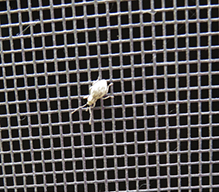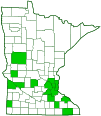imported long-horned weevil
(Calomycterus setarius)
Conservation • Description • Habitat • Ecology • Distribution • Taxonomy
Conservation Status |
|
|||||||
| IUCN Red List | not listed |
|||||||
| NatureServe | NNA - Not applicable |
|||||||
| Minnesota | not listed |
|||||||
Description |
||
Imported long-horned weevil is a small, exotic, flightless, broad-nosed weevil. It is native to Japan. It was first reported in the United States in Yonkers, NY in 1929. Thousands of the weevils were seen in a localized area, indicating that it had been present for a few years. Since then, it has spread rapidly. It now occurs in the United States from Maine to North Carolina, west to Minnesota and Oklahoma, and in southern Quebec and Ontario Canada. The larvae feed on the roots of alfalfa, aster, clover, goldenrod, and several species of grasses. Adults have been reported feeding on at least 100 species of forbs, shrubs, trees, and grasses. They often occur in explosive populations and can completely defoliate plants. They are a minor pest of soybean crops. However, even when they occur in very large numbers, they do not cause economic injury. Adults are ⅛″ to 3⁄16″ (3.6 to 4.7 mm) in length. The body is oval, robust, and dark reddish brown to black, but is densely covered with grayish white scales and erect bristles. The head, the plate on the first segment of the thorax (pronotum), and the hardened wing covers (elytra), often have some brown scales, giving the individual a darker appearance. The head and snout (rostrum) together are longer than the front part of the body (prothorax). The rostrum is short and broad, and expanded at the tip. The tip of the rostrum has two grooves and a V-shaped ridge. The antennae are reddish-brown or brown and bent (elbowed). They have 11 segments. The first segment (scape) is slightly curved and long, extending to the front margin of the prothorax. The last three segments are slightly expanded, forming a weak club. The club is elongated and is pointed at the end. The section beyond the bend and supporting the club (funicle) is as long as the scape. The pronotum is wider than long, slightly wider in front than behind, and slightly rounded on the sides. The front margin is extended (lobed) on each side behind the eyes. The surface is coarsely pitted (punctate). The plate between the wing bases (scutellum) is not visible, The elytra are egg-shaped when viewed from above, convex when viewed from the side. Each elytron has 10 narrow longitudinal grooves. The intervals between the grooves are convex, those on the sides slightly convex, those in the middle more strongly convex. They are pitted (punctured) and there is a stiff bristle emerging from each puncture. The legs are reddish brown or brown and are covered with fine, reclining hairs (setae). The third segment (femur) of each leg are more or less club shaped, narrow at the base and broadest about the two-thirds point. At the widest point there is a very small, sharp tooth on the underside. |
||
Size |
||
Total length: ⅛″ to 3⁄16″ (3.6 to 4.7 mm) |
||
Similar Species |
||
Habitat |
||
|
||
Ecology |
||
Season |
||
One generation per year: late June to the first week of August |
||
Behavior |
||
Adults feed in groups on the upper parts of low growing plants. |
||
Life Cycle |
||
Females lay unfertilized eggs that produce only female offspring (parthenogenesis). In late fall the larvae burrow into the soil up to eleven inches, deep enough to avoid the freezing temperatures of winter. Adults emerge in late June and are most abundant in July and early August. |
||
Larva Food |
||
Small roots of alfalfa, aster, clover, goldenrod, and several species of grasses |
||
Adult Food |
||
Foliage and blooms of at least 100 species of forbs, shrubs, trees, and grasses |
||
Distribution |
||||
|
Sources |
|||
| 7/25/2023 | ||||
Occurrence |
||||
Common and increasing |
||||
Taxonomy |
|||
Order |
Coleoptera (Beetles) |
||
Suborder |
Polyphaga (Water, Rove, Scarab, Long-horned, Leaf, and Snout Beetles) |
||
Infraorder |
Cucujiformia |
||
Superfamily |
Curculionoidea (snout and bark beetles) |
||
Family |
Curculionidae (true weevils) |
||
Subfamily |
Entiminae (broad-nosed weevils) |
||
Tribe |
Cyphicerini (Oriental broad-nosed weevils) | ||
| Subtribe | Acanthotrachelina | ||
Genus |
Calomycterus | ||
Synonyms |
|||
|
|||
Common Names |
|||
imported long-horned weevil |
|||
Glossary
Elytra
The hardened or leathery forewings of beetles used to protect the fragile hindwings, which are used for flying. Singular: elytron.
Femur
On insects and arachnids, the third, largest, most robust segment of the leg, coming immediately before the tibia. On humans, the thigh bone.
Pronotum
The exoskeletal plate on the upper side of the first segment of the thorax of an insect.
Prothorax
The first (forward) segment of the thorax on an insect, bearing the first pair of legs but not wings.
Punctate
Dotted with pits (punctures), translucent sunken glands, or colored spots of pigment.
Rostrum
The stiff, beak-like projection of the carapace or prolongation of the head of an insect, crustacean, or cetacean.
Scape
In plants: An erect, leafless stalk growing from the rootstock and supporting a flower or a flower cluster. In insects: The basal segment of the antenna.
Scutellum
The exoskeletal plate covering the rearward (posterior) part of the middle segment of the thorax in some insects. In Coleoptera, Hemiptera, and Homoptera, the dorsal, often triangular plate behind the pronotum and between the bases of the front wings. In Diptera, the exoskeletal plate between the abdomen and the thorax.
Seta
A stiff, hair-like process on the outer surface of an organism. In Lepidoptera: A usually rigid bristle- or hair-like outgrowth used to sense touch. In mosses: The stalk supporting a spore-bearing capsule and supplying it with nutrients. Plural: setae. Adjective: setose.
Visitor Photos |
|||||
Share your photo of this insect. |
|||||
| This button not working for you? Simply email us at info@MinnesotaSeasons.com. Attach one or more photos and, if you like, a caption. |
|||||
Nancy Lundquist |
|||||
I find them on our patio door screen all the time. Not a good picture since my camera focused on the screen instead of the bug no matter what I tried. |
 |
||||
MinnesotaSeasons.com Photos |
|||||
|
|||||

Slideshows |
||

Visitor Videos |
|||
Share your video of this insect. |
|||
| This button not working for you? Simply email us at info@MinnesotaSeasons.com. Attach a video, a YouTube link, or a cloud storage link. |
|||
Other Videos |
|||


Created: 7/25/2023
Last Updated:

